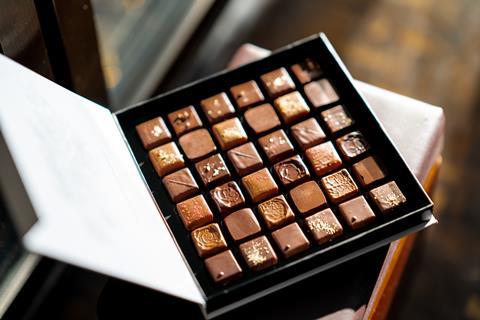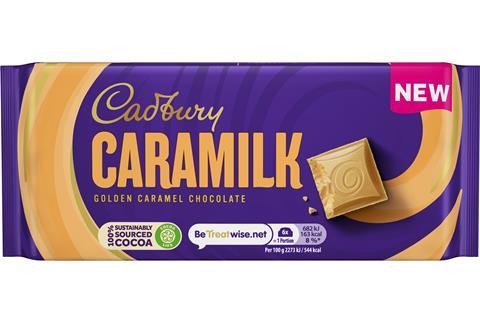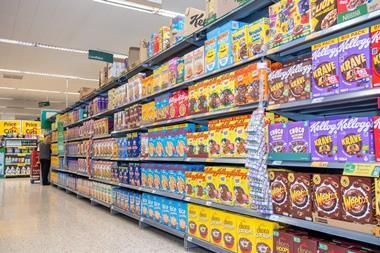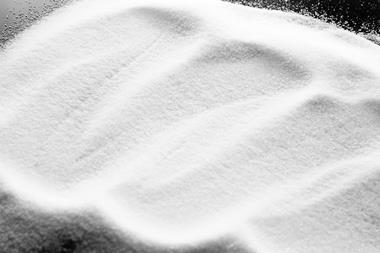
Chocolate is about to get whacked with a regulatory stick, as a clampdown on promotional space and deal mechanics looms for HFSS products. The good news for suppliers, however, is they have until October 2022 to prepare.
That gives them time to recoup lockdown-driven losses in impulse, on the go and meal deals. And to further cash in on demand for larger packs.
During Covid restrictions, shoppers favoured “take-home formats, with sharing blocks, multipacks and sharing bags driving growth, while on the go formats, especially singles, have seen steep decline,” explains NielsenIQ senior client manager Polina Jones.
“We’re starting to see a recovery for singles, but they haven’t regained their pre-Covid performance, as footfall is still below pre-pandemic levels.”
Nevertheless, by accelerating the switch to sharing formats, chocolatiers have emerged from the coronavirus storm in pretty good shape. Overall chocolate sales have grown by £147.7m – quite the reversal from the £1.6m loss in Top Products 2020. Lindt Lindor, Ferrero Rocher and Galaxy are the fastest growers, with respective gains of £33.3m, £16.2m and £15.6m – all having muscled in on at-home sharing occasions with posh lines.
Lindt Lindor has stolen Maltesers’ position as the UK’s third-biggest chocolate brand by expanding pick ‘n’ mix bays into more than 100 Sainsbury’s stores and launching a Salted Caramel variant.
Ferrero Rocher, meanwhile, added a trio of blocks in August, having seen strong growth for its 300g sharing boxes. And Galaxy’s Smooth Milk and Orange blocks have been key growth drivers for the brand.
“Increased treating moments at home, and the growth of the big night in, have seen consumers turn to products that enable them to celebrate moments together all year round and to gift those who they may not have been able to see,” says Ferrero customer development director Levi Boorer. “As a result, premium boxed chocolate has proven to be one of the most resilient sectors in confectionery over the past 18 months.”
Another significant factor in chocolate’s growth was a recovery over the 2021 Easter trading period. In April 2020, when grocers and their suppliers were still getting to grips with how the pandemic was altering shopper behaviour, Easter egg sales were hit hard. As a result, supermarkets were forced into a fire sale following the bank holiday weekend to sell off unsold stock.
This year was different. “Easter 2021 saw a very strong performance after the lockdown Easter of 2020, with most retailers running out of chocolate eggs on Easter Sunday,” says Jones. “Boxed chocolates grew by £55m and Easter chocolate grew by £44m – and this was heavily influenced by the performance of Lindt Lindor.”

With the luxury market driving strong growth, Mars Wrigley is having a stab at posh chocolate, too. Last December, the company announced a major rebranding for Galaxy and unveiled a trio of luxury sharing blocks under the new sub-brand Galaxy Fusions.
Galaxy “must continue to evolve,” senior brand manager Ellyse O’Connor told The Grocer at the time. “The new redesign will attract new customers and boost sales for retailers by standing out on shelves and starting conversation.”
The brand’s added £15.6m in the past 12 months. But year-on-year comparisons don’t tell the whole story. The rise of Galaxy comes after a disastrous 2020 for Mars, resulting from shortages caused by a breakdown at its Slough plant. Even with its growth in the past 52 weeks, Galaxy is still down £16.2m compared with 2019. Mars’ brands have suffered a combined loss of £98m over the past two years, with Galaxy, Maltesers (down £29.6m), M&M’s (down £16.2m) the biggest contributors. Meanwhile, Mars’ rivals have cashed in. Ferrero’s combined sales since 2019 are up by £20.9m, Lindt & Sprüngli is up by £66.9m and Mondelez is up by £130m.
Innovation has been crucial to this growth, says Mondelez trade communications manager Susan Nash, pointing to the £8.5m Cadbury Caramilk (see Top Launch, p89) has racked up since its June 2021 debut.
“Our biggest chocolate launch this year is bringing shoppers a new taste from Cadbury,” she adds. “Available now in tablet and single bar formats to drive returning impulse sales, Cadbury Caramilk is helping retailers recruit new shoppers with its unique taste from a trusted, recognisable brand.”
Jones at Nielsen adds that Caramilk was a key contributor to the extra £40m that’s been spent on chocolate sharing blocks over the past year. “Cadbury sharing blocks’ £21m growth was heavily driven by new product launches such as Mini Egg Bars, Caramilk and White Oreo,” she says. “Another noteworthy sharing block brand to keep an eye out for is Tony’s Chocolonely, which has added £9.8m (115.6%) to growth.”
Tony’s cashes in
That Tony’s has racked up overall sales of £18.2m in the past year is impressive, given the Dutch brand entered the UK less than three years ago with its mission to end slavery in the chocolate supply chain.
The dent it’s made on the market is a mark of growing demand for premium, luxury chocolate and the wider success of brands that market themselves on their ethical or sustainability credentials.
That next year’s HFSS regulations include heavier restrictions on how, when and to whom chocolate brands can advertise their products could benefit challenger brands like Tony’s, suggests UK & Ireland GM Ben Greensmith.
“Big chocolate companies spend billions on marketing. We’ve not traditionally spent on these channels as it’s hard to compete and cut through against such huge budgets. So, this area won’t impact Tony’s too much,” he told The Grocer in September. “If anything, it levels the playing field somewhat for smaller brands.”
However, it could be quite the opposite situation for big brands’ sharing tub and tins, which rely on prime positions front of store to drive sales. “Top brands that are likely to be most affected would include Celebrations, Quality Street and Cadbury Heroes,” according to Jones.
“These brands are more reliant on front of store position and multibuy offers. Retailers will need to rethink the main fixture to mitigate the loss of visibility and multibuys.”
Grocers could have some awkward chats with chocolate makers ahead of them.
Top Launch 2021
Cadbury Caramilk | Mondelez

After causing a sensation in Australia a couple of years ago, Cadbury Caramilk finally arrived in the UK in June. It’s a caramel-flavoured white chocolate, which Mondelez is targeting at younger shoppers through in-store, sampling, OOH and social media activity. Promising a “smooth, silky texture that melts in your mouth”, Caramilk is available as a countline (rsp: 69p/37g) and a tablet (rsp: £1.50/90g). It was followed in October by the two-strong Cadbury Plant Bar range of vegan chocolate.
The Grocer’s Top Products Survey 2021: who’s up, who’s down – and our overview of the key trends

Covid, Brexit costs and shortages in labour and material have caused chaos in grocery this year. Which sectors are best placed to deal with the inflationary storm on the horizon in 2022?
- 1
- 2
- 3
- 4
- 5
- 6
- 7
- 8
- 9
- 10
- 11
- 12
 Currently
reading
Currently
reading
Confectionery – chocolate 2021: choc rallies as HFSS ban looms
- 14
- 15
- 16
- 17
- 18
- 19
- 20
- 21
- 22
- 23
- 24
- 25
- 26
- 27
- 28
- 29
- 30
- 31
- 32
- 33
- 34
- 35
- 36
- 37
- 38
- 39
- 40
- 41
- 42
- 43
- 44
- 45
- 46
- 47
- 48
- 49




















































































































No comments yet